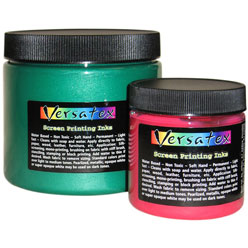Uses
For Textiles:
Versatex may be used on all types of fabric. The colors are semi transparent so they
work best on light colored fabrics. Versatex Printing extender VPI #300 may be added
for obtaining pastels and transparent overlays. Mix colors with white for opaque pastels.
Overlapping transparent colors produce new shades. The primaries combine well to make a
variety of colors. Colors are their deepest when applied at packaged strength. For
permanency and wash fastness on fabric the printing inks must be heat set (see
instructions below).
For paper:
Use cotton rag papers suitable for serigraphy. Versatex Printing Inks work best on
white or light tones of paper due to the transparency of the inks. The consistency of
the inks is suitable for direct application. They will not wrinkle or bleed on paper.
They are strongest when applied at packaged strength, and may be thinned with extender
for overlays and pastel tones.
Other Uses
Use decorator blocks, stiff brushes, or short
napped roller for painting on fabric. Be sure to work color into fabric, avoiding
excessive build up of color. Natural bristle brushes are preferable, as used for oil
or watercolor painting. Stencils are useful for repeat designs and masking tape is an
easy way to make stripes and crisp edges. Painting with a sponge can produce interesting
half tone effects. Versatex will print effectively over light to medium tones, but
will not hide dark tones.
420 M Metallics
Versatex colors are press ready, metallic textile inks. These inks are utilized
to achieve a shimmering affect when exposed to sunlight and reflect when in direct
light in night. These inks possess excellent colorfastness. Even though they are made
with higer solids content, they will produce a softer hand than many other types of
ink. These inks can be printed on both light and dark fabrics. Inks contain glitter
and should be mixed well before using. Substrates: cottons, contt/polyester blends,
terry cloth, canvas, and natural fibers, nylons. End Uses: t-shirts, colored t-shirts,
high fashion garments, towels and sweatshirts, nylons. Screen Mesh: excellent run
abilitiy with meshes 60 to 86 monofilament polyesters.
Other Notes
Mix or blend your own colors by using a medium speed mechanical mixer. All colors
may be intermixed but test for color accuracy before applying. Be sure to leave
screen flooded while printing or during delays in the printing process. In low humidity
or when it is hot use a spray bottle with water to keep ink moist.
Heat-Setting Instructions for Fabric
For best results allow painted or printed fabric to dry thoroughly, approximately one
half hour, or for faster drying, place under a lamp, then heat-set. Heat setting locks
color into fibers allowing for normal laundering.
Setting in a Dryer: Home dryers DO NOT work. Use a commercial dryer at 250 degrees
minimum for 45 minutes. Be sure to pre-heat dryer
Setting with an Iron: When using an iron, pre-heat iron at maximum temperature
for fabric. Place aluminum foil on ironing board and the painted side of the fabric down.
Press against the backside for 15-25 seconds per square foot.
Use in a Commercial Conveyor Type Oven: 350 degrees for 3 minutes and two passes
if necessary. Fabric should be hot to the touch in order to set colors.
Versatex Fixative Even easier (and softer!); mix Inks with Versatex Fixative right before use for permanent results without heat setting! Customers who have tried it are very impressed!
Note: Versatex Fixer can be used with the
Versatex Printing Inks to increase wash fastness and to assist in the heat setting
process. Add 1% to 3% by volume to Printing Ink. The pot life of the ink after
addition of Fixer is 6 hours. After application allow ink to dry for 12 hours
before heat setting at 225 - 300 degrees. Or let dry 4-6 days without heat setting
before washing. Always do test runs before running productions.






















































